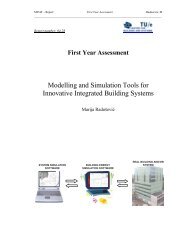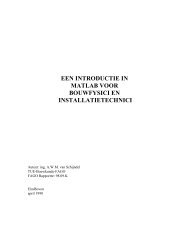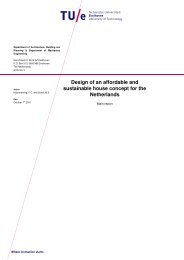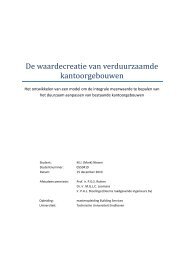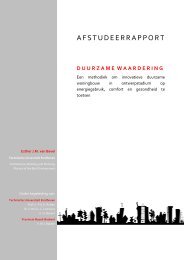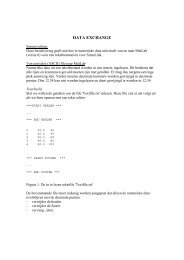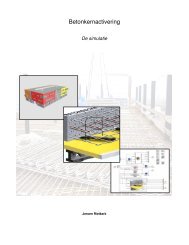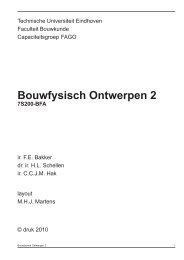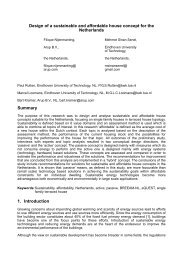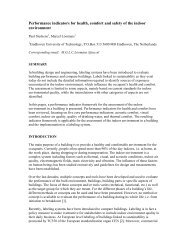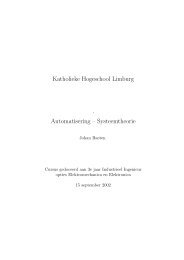preprint - Unit BPS
preprint - Unit BPS
preprint - Unit BPS
You also want an ePaper? Increase the reach of your titles
YUMPU automatically turns print PDFs into web optimized ePapers that Google loves.
Accepted for publication in Atmospheric Environment, September 29, 2010CFD simulation of near-field pollutant dispersion on a highresolutiongrid: a case study by LES and RANSfor a building group in downtown MontrealP. Gousseau∗ a , B. Blocken b , T. Stathopoulos c , G.J.F. van Heijst da Building Physics and Systems, Eindhoven University of Technology, P.O. Box 513, 5600 MB Eindhoven, TheNetherlands, p.gousseau@tue.nlb Building Physics and Systems, Eindhoven University of Technology, P.O. Box 513, 5600 MB Eindhoven, TheNetherlands, b.j.e.blocken@tue.nlc Building, Civil and Environmental Engineering, Concordia University, 1455 Blvd. de Maisonneuve West,Montreal, Quebec, Canada, H3G 1M8, statho@bcee.concordia.cad Fluid Dynamics Laboratory, Department of Physics, Eindhoven University of Technology, P.O. Box 513, 5600MB Eindhoven, The Netherlands, g.j.f.v.heijst@tue.nlAbstractTurbulence modeling and validation by experiments are key issues in the simulation of micro-scaleatmospheric dispersion. This study evaluates the performance of two different modeling approaches (RANSstandard k-ε and LES) applied to pollutant dispersion in an actual urban environment: downtown Montreal. Thefocus of the study is on near-field dispersion, i.e. both on the prediction of pollutant concentrations in thesurrounding streets (for pedestrian outdoor air quality) and on building surfaces (for ventilation system inlets andindoor air quality). The high-resolution CFD simulations are performed for neutral atmospheric conditions andare validated by detailed wind-tunnel experiments. A suitable resolution of the computational grid is determinedby grid-sensitivity analysis. It is shown that the performance of the standard k-ε model strongly depends on theturbulent Schmidt number, whose optimum value is case-dependent and a priori unknown. In contrast, LES withthe dynamic subgrid-scale model shows a better performance without requiring any parameter input to solve thedispersion equation.Keywords: Computational Fluid Dynamics (CFD); Large Eddy Simulation (LES); gas pollution; urban area;wind flow.1. IntroductionOutdoor air pollution is associated with a broad spectrum of acute and chronic health effects (Brunekreef andHolgate, 2002). The pollutants that are brought into the atmosphere by various sources are dispersed (advectedand diffused) over a wide range of horizontal length scales. Micro-scale dispersion refers to processes actingwithin horizontal length scales below about 5 km. It can be studied in detail by wind-tunnel modeling and bynumerical simulation with Computational Fluid Dynamics (CFD). Wind-tunnel modeling is widely recognizedas a valuable tool in wind flow and gas dispersion analysis but it generally only provides data at a limitednumber of discrete positions and it can suffer from incompatible similarity requirements. CFD does not havethese two disadvantages; it provides “whole flow-field” data and it can be performed at full scale. Furthermore, itis very suitable for parametric studies for various physical flow and dispersion processes. On the other hand, theaccuracy of CFD is a main concern, and grid-sensitivity analysis and experimental validation studies areimperative.In the past decades, CFD has been used extensively in micro-scale pollutant dispersion studies. A distinctioncan be made between generic studies and applied studies. Generic studies include configurations such asidealized isolated buildings (e.g. Leitl et al., 1997; Li and Stathopoulos, 1997; Meroney et al., 1999; Blocken etal., 2008; Tominaga and Stathopoulos, 2009; Santos et al., 2009), idealized isolated street canyons (e.g. Leitl andMeroney, 1997; Chan et al., 2002; Gromke et al., 2008) or regular building groups (e.g. Kim and Baik, 2004; Shiet al., 2008; Wang et al., 2009; Buccolieri et al., 2010; Dejoan et al., 2010). Applied studies refer to actual(isolated) buildings or actual building groups (urban areas) (e.g. Hanna et al., 2006; Patnaik et al., 2007; Baik etal., 2009; Pontiggia et al., 2010).∗ Corresponding author: Pierre Gousseau, Building Physics and Systems, Eindhoven University of Technology, P.O. Box513, 5600 MB Eindhoven, The Netherlands. Tel.: +31 (0)40 247 4374, Fax +31 (0)40 243 8595E-mail address: p.gousseau@tue.nl1
Many previous studies have indicated that CFD simulations based on the steady Reynolds-Averaged Navier-Stokes (RANS) equations are deficient in reproducing the wind-flow patterns (e.g. Murakami et al., 1992) andnear-field pollutant dispersion concentrations around buildings (e.g. Leitl et al., 1997; Meroney et al., 1999;Blocken et al., 2008; Tominaga and Stathopoulos, 2010), which motivates the use of Large Eddy Simulation(LES) for micro-scale pollutant dispersion. A number of authors have applied LES to dispersion around isolatedbuildings (e.g. Tominaga et al., 1997; Sada and Sato, 2002) and in street canyons (e.g. Li et al., 2008; Hu et al.,2009). One of the main concerns in micro-scale atmospheric dispersion modeling, however, is determining thespread of pollutants from sources in actual urban environments. During the past decade, the continuous progressin computational power has allowed us to also apply LES to this kind of street-scale dispersion problems. Anoverview of previous LES studies in actual urban areas is provided in Table 1. For every study, the city nameand location, the spatial extent of the urban study (near-field or far-field) and the subgrid-closure scheme arelisted. It is also indicated whether RANS simulations were performed and whether validation by comparisonwith experiments was conducted. Finally, also the cell type and the grid resolution are reported. The presentstudy aims at expanding the current state of the art in LES dispersion modeling, as discussed below.The previous studies all involved a large group of buildings (13 or more) with the primary intention todetermine the far-field spread of contaminants released from a source through the network of city streets andover buildings. This type of studies is called “far-field” dispersion studies in the framework of this paper. Giventhe extent of the computational domains involved, the grid resolutions in these far-field studies are generallyrelatively low, with a minimum cell size of the order of 1 m. An exception to this is the study by Camelli et al.(2005), who used cell sizes down to 0.22 m. Although the results provided by LES are generally promising,comparison with experimental data was only performed in two studies. For dispersion in actual urban areas, therelative performance of LES compared to RANS is not well known, as this was not addressed in previousstudies.Table 1Up to now, to the knowledge of the authors, no high-resolution CFD studies of near-field gas dispersion forrelatively large building groups which are accompanied by grid-sensitivity analysis and validation bycomparison with experiments have been performed. The aim of this paper is to present this kind of study forpollutant dispersion around a building group in downtown Montreal. The focus is both on the prediction ofpollutant concentrations in the surrounding streets (for pedestrian outdoor air quality) and on the prediction ofconcentrations on building surfaces (for ventilation system inlets placement and indoor air quality), i.e. twozones close to the source where the computation of the concentration distribution is known to be particularlychallenging. The CFD simulations are validated by detailed wind-tunnel experiments performed earlier byStathopoulos et al. (2004), in which sulfur-hexafluoride (SF 6 ) tracer gas was released from a stack on the roof ofa three-storey building and concentrations were measured at several locations on this roof and on the facade of aneighboring high-rise building. Note that earlier CFD studies for the same case included none or only one of theneighboring buildings (Blocken et al., 2008; Lateb et al., 2010), while in the present study, surrounding buildingsare included up to a distance of 300 m. For this purpose, a high-resolution grid with minimum cell sizes down toa few centimeters (full-scale) is used. The grids are obtained based on detailed grid-sensitivity analysis. BothLES and RANS simulations are performed.2. Description of the experimentsExperiments of pollutant dispersion in downtown Montreal were conducted in 2004 by Concordia Universityand IRSST 1 (Stathopoulos et al., 2004). Two types of experiments were conducted: on-site and in the ConcordiaUniversity boundary layer wind tunnel (Stathopoulos, 1984), with a scale factor of 1/200. SF 6 was used as tracergas and released from a stack located on the roof of the BE building, which is a three-storey building in the citycenter (Fig. 1). In the present study, the laboratory experiments are reproduced. The reason for this choice is thehigher controllability of the boundary conditions offered by wind-tunnel modeling, which allows a more reliableevaluation of the CFD simulations. The dimensions are expressed at model scale unless specified otherwise.Figure 1The test section of the wind tunnel is 12.2 m long, 1.8 m high and 1.8 m wide. A combination of vortexgenerators and roughness elements along the test section floor allows the simulation of the atmospheric boundarylayer (ABL). The mean velocity profile of the neutral ABL is given by:1 Institut de recherche Robert-Sauvé en Santé et en Sécurité du Travail2
3.1. The RANS standard k-ε modelAll the steady RANS simulations presented in this paper use the standard k-ε turbulence model (SKE) (Jones andLaunder, 1972). The intention is to test the ability of this widely used model to predict concentrationdistributions in complex geometries. In addition to the averaged momentum, continuity and energy equations,two other equations are solved for the transport of k, the turbulent kinetic energy, and ε, the turbulent dissipationrate. SKE is used in combination with the Boussinesq hypothesis, which relates the Reynolds stresses to themean-velocity gradients. This relation involves the turbulent viscosity ν t , which can be calculated from k and ε.When using SKE in the present study, all the transport equations are discretized using a second-order upwindscheme. Pressure interpolation is second order. The SIMPLE algorithm is used for pressure-velocity coupling.The gradients are computed in a discrete way, based on the Green-Gauss theorem (Fluent Inc., 2006).Convergence is assumed to be obtained when all the scaled residuals (Fluent Inc., 2006) reach 10 -6 . The valuesof the model constants are: C 1ε = 1.44; C 2ε = 1.92; C µ = 0.09; σ k = 1.0; σ ε = 1.3.The application of the Reynolds-averaging operator to Eq. (3) leads to the appearance of the turbulent massflux q t representing the effects of turbulence on mass transfer. Since in turbulent flows this flux largelydominates molecular diffusion, the accuracy of the concentration field prediction is strongly linked to the modelused to determine q t . By analogy with molecular diffusion, it is assumed to be proportional to the gradient ofmean concentration: q t = -D t ∇C, where D t is the turbulent mass diffusivity (m 2 s -1 ) and C is the meanconcentration (kgm -3 ). D t is often assumed to be proportional to the turbulent viscosity. The relation involves adimensionless parameter known as the turbulent Schmidt number (Sc t = ν t /D t ). Variations in the value of Sc t areknown to have a large influence on the concentration field (Tominaga and Stathopoulos, 2007; Blocken et al.,2008). In this study, three values of Sc t are used: 0.3, 0.5 and 0.7, which are in the range of those used inprevious studies (e.g. Tominaga and Stathopoulos, 2007; Blocken et al., 2008).3.2. Large Eddy SimulationIn the filtered Navier-Stokes equations, the SGS stresses τ ij represent the effect of the small eddies on theresolved field of motion. In order to close the equations for the filtered velocity, the dynamic Smagorinsky SGSmodel (Smagorinsky, 1963; Germano et al., 1991; Lilly, 1992) is used in this study: the components of thedeviatoric SGS stress tensor (τ d ij ) are linked to the filtered rate of strain by a linear relation:dτ = −2υS ij (4)ijsgswhere ν sgs is the SGS turbulent viscosity (m 2 s -1 ) and S¯ ij = (∂ū i /∂x j +∂ū j /∂x i )/2 is the filtered rate of strain tensor.The mixing-length hypothesis is used to evaluate the SGS turbulent viscosity:υ = ( ∆) S (5)2sgsC swhere ∆ is the filter width (m), equal to the cubic root of the computational cell volume, S¯ = (2S¯ ij S¯ ij ) 1/2 is thecharacteristic filtered rate of strain and C s is the so-called Smagorinsky constant. In the present study, a dynamicprocedure is used to evaluate this parameter, based on the resolved field. To avoid instabilities, the C s value iskept in the range [0; 0.23] (Fluent Inc., 2006).In the LES computations in this paper, the momentum equation is discretized with a bounded centraldifferencing scheme and a second-order upwind scheme is used for the energy and SF 6 concentration equations.Pressure interpolation is second order. Time integration is second order implicit. The non-iterative fractional stepmethod (Bell et al., 1989) is used for time advancement. This method allows reducing computational time byperforming only a single outer iteration per time step. For the pressure equation, the sub-iterations end within atime step when the ratio of the residual at the current sub-iteration and the first sub-iteration is less than 0.25,with a maximum of 10 sub-iterations per time step. For all the other equations, this ratio and this maximum are0.05 and 5, respectively.The application of the filtering operator to Eq. (3) leads to the appearance of an SGS mass flux term q sgs ,which represents the effects of the scales that are smaller than the filter size on the resolved concentration field.It is assumed to be proportional to the gradient of filtered concentration: q sgs = -D sgs ∇c¯ , where D sgs is the SGSmass diffusivity (m 2 s -1 ). In the present study, this parameter is evaluated dynamically at each time step based onthe resolved concentration field, in the same way as C s .4
4. Domain, grid and boundary conditions4.1. DomainTwo computational domains have been created, one for each wind direction (see Figures 2b and 3b). The inletand outlet planes are perpendicular to the flow direction, as required by the vortex method (Mathey et al., 2006)used to generate a time-dependent velocity profile at the inlet (more details in section 4.4). The streamwise,spanwise and vertical coordinates are denoted by x, y and z, respectively. The BE building is modeled in detail,including the roof-top structures. The other buildings are modeled based on the available full-scale data; they cantherefore show some slight differences with the wind-tunnel model. Some simplifications are made to limit thenumber of cells and to make the simulations computationally “affordable”: the vegetation is omitted (see Fig. 2a,on the left side), the side walls of the test section are not included as “walls” and, in the case SW, the mostupstream buildings are not explicitly modeled because they are assumed to have limited influence on the plumedispersion. Note that in both case SW and W, at least one street block in each direction is explicitly modeled, inagreement with Tominaga et al. (2008b). The domain dimensions are based on the COST Action 732 guidelines(Franke et al., 2007). For case SW, the domain dimensions are 5x2.125x1.65 m 3 (full-scale: 1 000x425x330 m 3 )in x, y, z direction. For case W, the domain dimensions are 5.75x2.3x1.65 m 3 (full-scale: 1 150x460x330 m 3 ).4.2. Computational gridsThe high-resolution computational grids are composed of hexahedral cells arranged in a horizontallyunstructuredand vertically-structured way. They have been created by using the surface-grid extrusion techniqueby van Hooff and Blocken (2010). In the present study, the grid is first created in a horizontal plane and thenswept in the vertical direction. This technique allows a large degree of control over cell shapes and sizes andavoids the use of tetrahedral and pyramid cells. For each case, RANS and LES are applied on the samecomputational grid. Previous numerical simulations of pollutant dispersion from a stack in a simpleconfiguration (not presented here; see also Tominaga et al. (1997)) have shown the importance of meshing theoutlet face of the stack with a high resolution. Hence, the range of cell dimensions is broad: from a fewcentimeters around the stack exhaust to several meters close to the boundaries of the domain, in full-scaledimensions. The ratio of two neighboring cell dimensions is kept around a value of 1.1.For case SW, three different grid resolutions are used to analyze the grid sensitivity of the results. Themedium grid, named SW-m, is composed of 4 791 744 cells. The stack circumference is divided into 32segments. To ensure a reasonable aspect ratio of the cells around the stack exhaust, their vertical dimension iskept small. Because the grid includes the four stack locations, the resolution on the surface of the BE building isvery high: 130x96x49 cells including the roof-top structures. The resolution of the grid on the neighboringbuildings ranges from 0.005 to 0.015 m (full-scale: 1 to 3 m), depending on the dimensions and the location ofthe building. In any case, a minimum of 10 cells per building height and between buildings in the horizontalplane has been used (Franke et al., 2007). Away from the area of interest, the grid size tends progressively to0.04 m (full-scale: 8 m). To analyze the effect of grid resolution on RANS and LES simulations, two additionalcomputational grids are created: one finer (SW-f) and one coarser (SW-c). Refinement and coarsening areperformed by multiplying the cell dimensions on the edges of the buildings by a constant factor (1.26 for SW-cand 0.8 for SW-f). For case SW-f, refinement is not performed farther than one street block away from the BEbuilding to limit the total number of cells. The main grid characteristics are summarized in Table 3.Following the conclusions of the grid-sensitivity analysis for case SW (see Section 5.1), the computations forcase SW are performed with grid SW-m, and those for case W with a grid with a similar resolution (named W-m) which contains 5 257 343 cells.Table 34.3. Boundary conditionsWith SKE, the profiles of U, k and ε are prescribed at the inlet of the domain, based on the measurements in thetest section of the wind tunnel (see Section 2). To generate a time-dependent velocity profile with LES, thevortex method is used (Mathey et al., 2006). In the inlet plane, a given number N of vortices are generated andconvected randomly at each time step. Their intensity and size depends on the local value of k and ε whoseprofiles are prescribed at the inlet like for SKE. The fluctuations around the prescribed mean streamwise velocityare deduced from the perturbation caused by the vortices in the inlet plane. More details about this technique andvalidation studies can be found in Mathey et al. (2006). Previous studies on air flow around a wall-mounted cube5
(not presented here) have shown that the flow field can be simulated in an accurate way with N = 190; this valuehas therefore been retained for the present LES computations.The exit face of the stack is defined as a velocity inlet with a uniform velocity profile. Turbulence quantitiesare computed based on the hydraulic diameter (D h = 0.002 m) and an assumed value of turbulence intensity of10%.At the top and lateral boundaries, symmetry boundary conditions are prescribed. At the outlet plane, zerostatic pressure is imposed. All building surfaces are defined as smooth no-slip walls. For simulations with theSKE turbulence model, the standard wall functions (Launder and Spalding, 1974) are applied to compute thevariables – including c – in the wall-adjacent cells. For case SW-m, the maximum value of y* on the buildingwalls is equal to 830 (y* = C µ 1/4 k P 1/2 z P /ν, where k P is the value of k at the centroid P of the wall-adjacent cells, z Pis the height of P and ν is the kinematic viscosity of the fluid). However, in a large majority of the cells, y* isbelow 300, which justifies the use of the wall functions. With LES, the centroids of the wall-adjacent cells areassumed to fall in the logarithmic law region of the boundary layer (Fluent Inc., 2006).The ground is defined as a rough wall boundary to take into account the effects of the surrounding terrain(i.e. all the buildings that are not explicitly modeled in the computational domain) on the ABL flow. With SKEand the standard wall functions, the roughness of the wall is characterized by the sand-grain roughness height k s(m) and the roughness constant C r . In order to limit the longitudinal gradients which occur because of theincompatibility of the wall functions with the ABL profiles, these parameters are chosen according to the relationk s = 9.793 z 0 /C r (Blocken et al., 2007), where k s is taken smaller than z P (e.g. z P = 0.00125 m for SW-m and W-m). In Fluent 6.3, a too high input value of C r can create numerical instabilities so in this case where z 0 is highand k s is low (e.g. k s = 0.0012 m for SW-m and W-m), the C r value is bounded to 7. Therefore, some longitudinalgradients will occur. The wall treatment used with LES in Fluent does not take into account the roughness of thewall. To limit the longitudinal gradients of the inflow profiles in both the RANS and LES simulations, theupstream length of the domain has been kept intentionally short (around 0.3 m). In addition, it is reasonable toassume that the flow patterns around the BE building are to a large extent determined by the neighboringbuildings and that the influence of the short-fetch upstream degradation of ABL flow is low.4.4. Unsteady parameters for LESAs pointed out in section 4.2, the large dimensions of the domain combined with the necessity to refine thegrid around the source location lead to heterogeneous cells dimensions in the computational grid. On the onehand, the time step size is usually limited by the dimensions of the smallest cells. On the other hand, the largedimensions of the domain require a long averaging time to get a statistically-steady solution: several “flowthrough”time units (T = L/U ref where L is the domain dimension in the streamwise direction) are generally used.In practice, satisfying these two conditions is not affordable in terms of computational time and a compromisemust be made.For the medium grid, the time step is set to ∆t = 5.10 -4 s, which leads to a Courant number (= u∆t/h, where uis the local velocity magnitude and h is the local grid size) below one in the majority of the cells. This valuecorresponds to the scaled-down model; the equivalent time step at full scale with the same reference velocity is0.1 s. The grid-sensitivity analysis was performed at constant Courant number: the time step has been increasedto 6.3.10 -4 s for grid SW-c and decreased to 4.10 -4 s for grid SW-f.The LES computations are initialized with the solution from the SKE simulations. Before averaging, thecomputation is run during 2 s to remove the influence of the initial condition. Then, data are averaged over aperiod of 4 s (full-scale: 800 s), corresponding to 10T. The monitored evolution of K with time (moving average)at the measurement points indicates that this period is long enough to get statistically steady values, although it issmaller than the averaging time in the wind tunnel.5. Results and discussion5.1. Grid-sensitivity analysis for case SWThe results of the simulations performed on the grids SW-c, SW-m and SW-f with SKE and Sc t = 0.5 are shownin Figure 5a, where the concentration values obtained with the coarse and fine grids (vertical axis) are comparedto those on the medium grid (horizontal axis). A slight change in the results can be observed from SW-c to SWm,whereas the results obtained with SW-m and SW-f are similar.In the case of LES with implicit filtering, the local filter width is equal to the computational cell size. As aconsequence, the LES model is in essence grid dependent and the conclusions of the grid-sensitivity analysis areless straightforward than in the RANS case. In particular, it is known that a grid-independent solution cannot befound (Klein, 2005). As can be seen in Figure 5b, it appears that the values predicted with SW-c are lower thanthose predicted with SW-m. In contrast, the use of the grid SW-f leads to a slight increase of the concentration6
values, especially at the points of lower concentration. It is argued that this slight difference does not justify thelarge increase in computational time required with SW-f. Thus, in the next section, the results of SW-m will bepresented and a resolution similar to SW-m was adopted for the study of case W.Figure 55.2. Comparison between standard k-ε and LES on medium grid for case SWThe values of non-dimensional concentration (100*K) obtained with the numerical simulations are compared tothe wind-tunnel results in the scatter plots of Figure 6. With SKE, it is clear that – as expected – variations of Sc tcan have a large influence on the concentration values (Fig. 6a). No large discrepancies are observed with LES:except for point 15 (on the Faubourg building), the computed K values are within a factor of three from thewind-tunnel measurements (Fig. 6b). It should also be noted that, except for point 9 (close from the stack), thevalues of K provided by the LES computation are all under-estimated compared to the experiment.Figure 6The average (e AVG ), maximum (e MAX ) and median (e MED ) values of the relative error over all the data pointsare given in Table 4. The relative error e (%) is defined for each data point by:KExp− KCFDe = 100 *(6)KExpwhere K Exp and K CFD are the measured and computed values of the concentration coefficient, respectively. Thelowest values of e AVG and e MAX with SKE are obtained with Sc t = 0.7; e MAX remains high, however. With LES,both e AVG and e MAX are low, and e MED is very close to the average value, which shows the symmetric distributionof the error values around e AVG . By contrast, e MED < e AVG for SKE denotes a skewed distribution of the errorvalues and the presence of outliers. Indeed, Table 5 shows that the value of e at point 9 (close to the stack) isvery high.Table 4Table 5Figure 7 shows the contours of non-dimensional mean streamwise velocity (U/U ref ) in the vertical plane y =y stack which is aligned with the flow direction and contains the center of the stack. In accordance with previousnumerical simulations for simplified building models (e.g. Murakami et al., 1992; Tominaga et al., 2008a), therecirculation zone in the wake of the Faubourg building (denoted by A) extends farther downstream with SKEthan with LES because of the under-estimation by SKE of the turbulent kinetic energy at this location. In thisregion, the backflow tends to transport the pollutant towards the Faubourg building. Indeed, with both models,the maximum concentrations occur on the leeward facade of the Faubourg building (Fig. 8) and theconcentration values on the building surfaces and the surrounding streets predicted with LES (Fig. 8b) areoverall lower than those predicted with SKE with Sc t = 0.7 (Fig. 8a). However, on the roof of the Faubourgbuilding, LES predicts high concentration values. This is not the case with SKE, and is attributed to the fact thatthis model does not reproduce the roof-top separation and recirculation zone B (Fig. 7).Figure 7Figure 85.3. Comparison between standard k-ε and LES on medium grid for case WFigure 9a shows that the simulations of case W with SKE show a poor agreement with the measurements. Thediscrepancy between CFD and experiments is minimal for Sc t = 0.3, as confirmed by the relative errors shown inTable 6. Figure 9b shows the scatter plots for the LES computation. Although maximum errors remain large, onaverage the accuracy is improved: the average relative error drops to 66.8% (Table 6).Figure 9Table 6The contours of 100*K on the building roofs and on the surrounding streets are shown in Figure 10. WithSKE, the horizontal spread of the plume increases as the value of Sc t decreases (not shown in the figure). Amongthe three values tested here, this spread is maximal for Sc t = 0.3 (Fig. 10a). Figure 10b shows that it is even7
higher with LES, resulting in higher concentration levels at the downstream neighboring streets. Note that withboth models the centerline of the plume is not aligned with the wind-flow direction: the complex interaction ofthe oncoming wind-flow with the buildings and the elevated rooftop structures of the BE building results in avelocity component in the y-direction at the location of the stack, which tends to deviate the plume. It seems thatthis deviation was not observed in the wind tunnel since the concentration values at the points located in the zoney ≤ y stack (namely: points 6, 9, 10, 13, and 14; see Table 7) are largely underestimated by the numericalsimulations. This can likely be attributed to the complex combination of vortex shedding from the Faubourgbuilding and the long roof-top structure on the BE building. Small deviations in reference wind direction areexpected to have a large influence here. Another high discrepancy occurs at point 1, very close to the stack,which appears to be one of the most difficult locations to predict.Figure 10Table 75.4. DiscussionNumerical simulation of atmospheric dispersion in urban environments is difficult and the selected turbulencemodeling approach largely determines the quality of the results.In the present study, the case where the BE building is located in the wake of a high-rise building (case SW)shows the best agreement between CFD and experiments, especially with LES. In this case, the pollutant istransported towards the leeward facade of the Faubourg building. From a practical point of view, if this winddirection is likely to occur often (which is the case in reality; see Stathopoulos et al. (2004)), ventilation intakesof the Faubourg building should preferably not be located on this facade and, according to the LES results, alsonot on the roof or the sides of the building. Pollutants can also contaminate the indoor air of the Faubourgbuilding if the windows of the leeward facade are open. Air quality can deteriorate in the street between the BEand Faubourg buildings (Fig. 8) and this can affect pedestrians. Why the concentration values predicted withLES are generally under-estimated compared to the experiment is not totally clear. A possible reason is the wayin which the concentration is computed in the cells adjacent to the building surfaces, where all data points arelocated. Further investigation of near-wall modeling effects on surface concentration predictions is required.Also for case W, LES provides more accurate concentration values on the roof of the BE building than SKE.For this wind direction, the plume trajectory is less disturbed than for case SW. The buildings locateddownstream will be affected by pollution. The horizontal spread of pollutant is high and the streets located in awide region downstream of the BE building will be polluted as well. The numerical simulations also indicate adeviation of the plume which is considered to be responsible for the significant under-estimation of K at thepoints located in the zone y ≤ y stack .For both wind directions under study, it was verified that the results of the SKE simulations are highlydependent on the value of Sc t . Moreover, its optimum is a priori unknown and strongly case-dependent. Forexample, among the three values tested, the best value is 0.7 for case SW and 0.3 for case W. By contrast, LESwith the dynamic Smagorinsky SGS model and the dynamic computation of D sgs can provide more accurateresults without any parameter input to solve the dispersion equation. This is considered a main advantage of theLES approach.Because it is an unsteady model, LES can also provide the extreme values of the concentration everywhere inthe domain. From a practical point of view, this information will be required when dealing with hazardousmaterials whose concentration must not exceed a certain threshold. However, LES is approximately seven timesmore demanding in terms of computational cost than SKE in this study where the same grid has been used forboth RANS and LES. LES is also very sensitive to the type and resolution of the computational grid used; in thepresent study, the refinement of the grid has led to an increase in the computed concentration values. Finally, itshould be emphasized that wind-tunnel experiments providing both velocity and concentration measurements inan actual urban environment would be of great interest for further evaluation and comparison of turbulencemodels applied to atmospheric dispersion problems.6. Summary and conclusionsHigh-resolution CFD simulation of near-field pollutant dispersion in a building group in downtown Montrealwas performed with two different turbulence modeling approaches: RANS standard k-ε and LES with thedynamic Smagorinsky SGS model. Contrary to most of the previous CFD studies of urban dispersion whichfocused on the far-field spread of contaminants, the present simulations focused on the concentration valuesclose to the source (on the building surfaces and in the surrounding streets) and were performed on highresolutiongrids. They were validated by comparison with wind-tunnel measurements for two different winddirections: south-west, for which a high-rise building is located immediately upstream of the emitting building,8
and west, for which the obstacles are located farther upstream. Both RANS and LES computations wereperformed on the same grids. The grid-sensitivity analysis indicated that the medium grid SW-m was suitable forthe problem. For this grid, the stack circumference was divided into 32 segments, the BE building wasdiscretized into 130x96x49 cells and a full-scale resolution of 1.5 to 3 m was used for the neighboring buildings.The agreement between numerical simulations and wind-tunnel measurements was good in the case SW butlarger discrepancies were observed in the case W. Nevertheless, LES was better in both cases and has theadvantage of solving the dispersion equation without any parameter input when the SGS mass diffusivity D sgs iscomputed with a dynamic procedure. The simulation by the numerical model of the flow separation at the sharpedges of the buildings appears to be crucial for the proper simulation of the concentration field. Future work willconsist of testing the ability of various turbulence modeling approaches and turbulence models to accuratelyreproduce flow separation on computationally affordable grids for generic cases including isolated buildings andstreet canyons. It will also include investigation of the influence of small deviations in wind direction on theconcentration field.AcknowledgementsThe numerical simulations reported in this paper were supported by the laboratory of the <strong>Unit</strong> Building Physicsand Systems (<strong>BPS</strong>) of Eindhoven University of Technology.ReferencesBaik J.J., Park S.B., Kim J.J., 2009. Urban flow and dispersion simulation using a CFD model coupled to amesoscale model. Journal of Applied Meteorology and Climatology 48(8), 1667-1681.Bell J.B., Glaz H.M., Colella P., 1989. Second-order projection method for the incompressible Navier-Stokesequations. Journal of Computational Physics 85, 257-283.Blocken B., Stathopoulos T., Carmeliet J., 2007. CFD simulation of the atmospheric boundary layer: wallfunction problems. Atmospheric Environment 41, 238-252.Blocken B., Stathopoulos T., Saathoff P., Wang X., 2008. Numerical evaluation of pollutant dispersion in thebuilt environment: Comparisons between models and experiments. Journal of Wind Engineering andIndustrial Aerodynamics 96, 1817-1831.Brunekreef B., Holgate S.T., 2002. Air pollution and health. Lancet 360, 1233-1242.Buccolieri R., Sandberg M., Di Sabatino S., 2010. City breathability and its link to pollutant concentrationdistribution within urban-like geometries. Atmospheric Environment 44(15), 1894-1903.Camelli F.E., Löhner R., Hanna S.R., 2005. Dispersion patterns in a heterogeneous urban area, in: Larreteguy A.(Ed.), Mecánica Computacional Vol. XXIV, Buenos Aires, Argentina, pp. 1339-1354.Chan T.L., Dong G., Leung C.W., Cheung C.S., Hung T.W., 2002. Validation of a two-dimensional pollutantdispersion model in an isolated street canyon. Atmospheric Environment 36(5), 861-872.Dejoan A., Santiago J.L., Martilli A., Martin F., Pinelli A., 2010. Comparison between large-eddy simulationand Reynolds-averaged Navier-Stokes computations for the MUST field experiment. Part II: Effects ofincident wind angle deviation on the mean flow and plume dispersion. Boundary-Layer Meteorology 135,133-150.Fluent 6.3 User’s Guide, Fluent Inc., Lebanon, 2006Franke J., Hellsten A., Schlünzen H., Carissimo B., 2007. Best practice guideline for the CFD simulation offlows in the urban environment. COST Action 732.Germano M., Piomelli U., Moin P., Cabot W.H., 1991. A dynamic subgrid-scale eddy viscosity model. Physicsof Fluids A 3, 1760-1765.Gromke C., Buccolieri R., Di Sabatino S., Ruck B., 2008. Dispersion study in a street canyon with tree plantingby means of wind tunnel and numerical investigations - Evaluation of CFD data with experimental data.Atmospheric Environment 42(37), 8640-8650.Hanna S.R., Brown M.J., Camelli F.E., Chan S.T., Coirier W.J., Hansen O.R., Huber A.H., Kim S., ReynoldsR.M., 2006. Detailed simulations of atmospheric flow and dispersion in downtown Manhattan. Anapplication of five computational fluid dynamics models. Bulletin of the American Meteorological Society87, 1713-1726.Hu L.H., Huo R., Yang D., 2009. Large eddy simulation of fire-induced buoyancy driven plume dispersion in anurban street canyon under perpendicular wind flow. Journal of Hazardous Materials 166, 394-406.Jones W.P., Launder B.E., 1972. The prediction of laminarization with a two-equation model of turbulence.International Journal of Heat and Mass Transfer 15, 301-314.Kim J.J., Baik J.J., 2004. A numerical study of the effects of ambient wind direction on flow and dispersion inurban street canyons using the RNG k-ε turbulence model. Atmospheric Environment 38(19), 3039-3048.Klein M., 2005. An attempt to assess the quality of large eddy simulations in the context of implicit filtering.Flow, Turbulence and Combustion 75, 131-147.9
Lateb M., Masson C., Stathopoulos T., Bédard C., 2010. Numerical simulation of pollutant dispersion around abuilding complex. Building and Environment 45, 1788-1798.Launder B.E., Spalding D.B., 1974. The numerical computation of turbulent flows. Computer Methods inApplied Mechanics and Engineering 3, 269-289.Leitl B.M., Meroney R., 1997. Car exhaust dispersion in a street canyon. Numerical critique of a wind tunnelexperiment. Journal of Wind Engineering and Industrial Aerodynamics 67 & 68, 293-304.Leitl B.M., Kastner-Klein P., Rau M., Meroney R.N., 1997. Concentration and flow distributions in the vicinityof U-shaped buildings: wind-tunnel and computational data. Journal of Wind Engineering and IndustrialAerodynamics 67 & 68, 745-755.Li X.-X., Liu C.-H., Leung D.Y.C., 2008. Large-eddy simulation of flow and pollutant dispersion in high-aspectratiourban street canyons with wall model. Boundary-Layer Meteorology 129, 249-268.Li Y., Stathopoulos T., 1997. Numerical evaluation of wind-induced dispersion of pollutants around a building.Journal of Wind Engineering and Industrial Aerodynamics 67 & 68, 757-766.Lilly D.K., 1992. A proposed modification of the Germano subgrid-scale closure method. Physics of Fluids A 4,633-635.Mathey F., Cokljat D., Bertoglio J.-P., Sergent E., 2006. Assessment of the vortex method for large eddysimulation inlet conditions. Progress in Computational Fluid Dynamics 6, 58-67.Meroney R.N., Leitl B.M., Rafailidis S., Schatzmann M., 1999. Wind-tunnel and numerical modeling of flowand dispersion about several building shapes. Journal of Wind Engineering and Industrial Aerodynamics 81,333-345.Murakami S., Mochida A., Hayashi Y., Sakamoto S., 1992. Numerical study on velocity-pressure field and windforces for bluff bodies by k-ε, ASM and LES. Journal of Wind Engineering and Industrial Aerodynamics 41-44, 2841-2852.Patnaik G., Boris J.P., Young T.R., 2007. Large scale urban contaminant transport simulations with Miles.Journal of Fluids Engineering 129, 1524-1532.Pontiggia M., Derudi M., Alba M., Scaioni M., Rota R., 2010. Hazardous gas releases in urban areas: assessmentof consequences through CFD modelling. Journal of Hazardous Materials 176, 589-596.Sada K., Sato A., 2002. Numerical calculation of flow and stack-gas concentration fluctuation around a cubicalbuilding. Atmospheric Environment 36, 5527-5534.Santos J.M., Reis N.C., Goulart E.V., Mavroidis I., 2009. Numerical simulation of flow and dispersion around anisolated cubical building: The effect of the atmospheric stratification. Atmospheric Environment 43(34),5484-5492.Shi R.F., Cui G.X., Wang Z.S., Xu C.X., Zhang Z.S., 2008. Large eddy simulation of wind field and plumedispersion in building array. Atmospheric Environment 42, 1083-1097.Smagorinsky J., 1963. General circulation experiments with the primitive equations. I. The basic experiment.Monthly Weather Review 91, 99-164.Stathopoulos T., 1984. Design and fabrication of a wind tunnel for building aerodynamics. Journal of WindEngineering and Industrial Aerodynamics 16, 361-376.Stathopoulos T., Lazure L., Saathoff P., Gupta A., 2004. The effect of stack height, stack location and roof-topstructures on air intake contamination - A laboratory and full-scale study. IRSST report R-392, Montreal,Canada, 2004.Tamura T., Nakayama H., Okuda Y., 2006. LES analysis on atmospheric dispersion in spatially-developingturbulent boundary layer in actual urban area. Journal of Environmental Engineering (Transactions of AIJ)604, 31-38.Tamura T., 2008. Towards practical use of LES in wind engineering. Journal of Wind Engineering and IndustrialAerodynamics 96, 1451-1471.Tominaga Y., Murakami S., Mochida A., 1997. CFD prediction of gaseous diffusion around a cubic model usinga dynamic mixed SGS model based on composite grid technique. Journal of Wind Engineering and IndustrialAerodynamics 67&68, 827-841.Tominaga Y., Stathopoulos T., 2007. Turbulent Schmidt numbers for CFD analysis with various types offlowfield. Atmospheric Environment 41, 8091-8099.Tominaga Y., Mochida A., Murakami S., Sawaki S., 2008a. Comparison of various revised k-ε models and LESapplied to flow around a high-rise building model with 1:1:2 shape placed within the surface boundary layer.Journal of Wind Engineering and Industrial Aerodynamics 96, 389-411.Tominaga Y., Mochida A., Yoshie R., Kataoka H., Nozu T., Yoshikawa M., Shirasawa T., 2008b. AIJ guidelinesfor practical applications of CFD to pedestrian wind environment around buildings. Journal of WindEngineering and Industrial Aerodynamics 96, 1749-1761.Tominaga Y., Stathopoulos T., 2009. Numerical simulation of dispersion around an isolated cubic building:Comparison of various types of k-ε models. Atmospheric Environment 43(20), 3200-3210.10
Tominaga Y., Stathopoulos T., 2010. Numerical simulation of dispersion around an isolated cubic building:model evaluation of RANS and LES. Building and Environment 45(10), 2231-2239.Tseng Y.-H., Meneveau C., Parlange M.B., 2006. Modeling flow around bluff bodies and predicting urbandispersion using large eddy simulation. Environmental Science & Technology 40, 2653-2662.Van Hooff T., Blocken, B., 2010. Coupled urban wind flow and indoor natural ventilation modelling on a highresolutiongrid: A case study for the Amsterdam ArenA stadium. Environmental Modelling & Software 25,51-65.Wang B.C., Yee E., Lien F.S., 2009. Numerical study of dispersing pollutant clouds in a built-up environment.International Journal of Heat and Fluid Flow 30, 3-19.Xie Z.-T., Castro I.P., 2009. Large-eddy simulation for flow and dispersion in urban streets. AtmosphericEnvironment 43, 2174-2185.11
FIGURE CAPTIONSFig. 1. View from south of the BE building and its surroundings in downtown Montreal and wind directionsconsidered in the present study.Fig. 2. Case SW: (a) wind-tunnel model and (b) corresponding computational grid on the building and groundsurfaces.Fig. 3. Case W: (a) wind-tunnel model and (b) corresponding computational grid on the building and groundsurfaces.12
Fig. 4. Measurement points on the roof of the BE building and facade of the Faubourg building and measuredconcentration values (100*K, between brackets) for (a) case SW and (b) case W. The stack location is indicatedby SL3 and SL1, respectively.Fig. 5. Grid-sensitivity analysis: scatter plots of 100*K values for case SW obtained with three different gridswith (a) SKE - Sc t = 0.5 and (b) LES.Fig. 6. CFD validation: scatter plots of 100*K values for case SW with (a) SKE and (b) LES in comparison withexperiments.Fig. 7. Contours of mean streamwise velocity (non-dimensionalized by U ref ) in the vertical plane y = y stack forcase SW obtained with (a) SKE and (b) LES. The dotted lines indicate the limits of the recirculation zones (A:wake; B: roof-top).13
Fig. 8. Contours of 100*K on building surfaces and surrounding streets for case SW obtained with (a) SKE - Sc t= 0.7 and (b) LES.Fig. 9. CFD validation: scatter plots of 100*K values for case W with (a) SKE and (b) LES in comparison withexperiments.Fig. 10. Contours of 100*K on building roofs and surrounding streets for case W obtained with (a) SKE - Sc t =0.3 and (b) LES.14
TABLESTable 1. Overview of previous and present LES computations of atmospheric dispersion in actual urban areas.Reference City Spatial Closure RANS Validation Cell type Resolutionextentby exp.Camelli etal. (2005)Tysons Corner,VA, USANew York, NY,Far-fieldFar-fieldSmagorinskySmagorinskyNoNo a NoNo a TetrahedralTetrahedral0.22 - 6.1m≥ 2 mUSATseng etal. (2006)Baltimore, MD,USAFar-fieldScaledependentLagrangiandynamicPatnaik et Los Angeles, Far-field Monotone No Yes (field Hexahedral 6 mal. (2007) CA, USAIntegratedexp.)Tamura Tokyo, Japan Far-field N/A No No N/A N/A(2008) bXie &Castro(2009)London, UK Far-field Smagorinsky No Yes (windtunnel)PolyhedralPresentsimulationMontreal, PQ,CanadaNo No Hexahedral 6-8cells/buildingNearfieldDynamicSmagorinskyYesYes (windtunnel)Hexahedral(Body-fitted)≥ 1.5 m0.04-8 m(full-scale)a Comparisons with RANS simulations and field measurements of velocity vectors at several points in Hanna etal. (2006)b Details in Tamura et al. (2006), in JapaneseTable 2. Parameters for the two case studies.Case Wind direction θ (°) Stack location h s (m) M (-)SW South-West 220 3 1 5W West 270 1 3 3Table 3. Main characteristics of the computational grids.Grid Nb of cells:TotalNb of cells:StackNb of cells:BE buildingCell size atother buildingscircumf.(m)SW-m 4 791 744 32 130x96x49 1.5 to 3 8SW-c 2 860 531 24 104x77x42 1.9 to 3.8 10SW-f 6 651 874 40 164x118x60 1.5 to 3 8W-m 5 257 343 32 136x104x51 1.5 to 3 8Table 4. Average, maximum and median values of the relative error for case SW-m.SKE - Sc t = 0.3 SKE - Sc t = 0.5 SKE - Sc t = 0.7 LESe AVG (%) 125.2 58.9 42.3 51.7e MAX (%) 1406.0 508.9 178.8 73.5e MED (%) 25.2 25.2 33.8 54.0Cell size at exterior domainboundaries (m)Table 5. Dimensionless concentration coefficient (100*K) and relative error values at each measurement pointfor case SW-m.Point 100*K Exp SKE - Sc t = 0.3 SKE - Sc t = 0.5 SKE - Sc t = 0.7 LESlabel100*K CFD e (%) 100*K CFD e (%) 100*K CFD e (%) 100*K CFD e (%)1 27 20.2 25.2 13.4 50.4 7.7 71.4 12.6 53.32 32 32.7 2.3 23.9 25.2 15.1 52.9 16.2 49.43 57 70.1 23.0 53.9 5.4 34.3 39.8 27.8 51.24 71 69.7 1.9 62.3 12.2 50.0 29.5 32.7 54.05 60 125.5 109.1 104.2 73.7 78.6 31.1 47.8 20.46 104 174.2 67.6 124.0 19.3 68.8 33.8 38.1 63.37 68 62.4 8.2 68.5 0.8 66.9 1.7 30.5 55.18 96 90.5 5.7 91.6 4.6 84.3 12.1 42.1 56.19 131 1972.8 1406.0 797.7 508.9 365.2 178.8 227.3 73.515
10 79 59.5 24.7 74.0 6.4 81.7 3.4 31.3 60.411 69 73.5 6.6 82.5 19.6 87.8 27.2 40.0 42.012 120 77.7 35.2 70.6 41.1 69.2 42.3 43.1 64.113 59 77.1 30.7 37.9 35.7 23.2 60.7 52.4 11.214 925 314.3 66.0 624.2 32.5 858.3 7.2 439.7 52.515 1050 354.0 66.3 548.2 47.8 596.0 43.2 327.2 68.8Table 6. Average, maximum and median values of the relative error for case W-m.SKE - Sc t = 0.3 SKE - Sc t = 0.5 SKE - Sc t = 0.7 LESe AVG (%) 80.2 81.5 82.9 66.8e MAX (%) 104.5 201.9 215.3 99.9e MED (%) 88.6 95.6 98.7 64.9Table 7. Dimensionless concentration coefficient (100*K) and relative error values at each measurement pointfor case W-m.Point 100*K Exp SKE - Sc t = 0.3 SKE - Sc t = 0.5 SKE - Sc t = 0.7 LESlabel100*K CFD e (%) 100*K CFD e (%) 100*K CFD e (%) 100*K CFD e (%)1 222 32.9 85.2 1.8 99.2 0.1 100.0 0.1 99.92 225 178.3 20.8 244.7 8.7 273.8 21.7 148.4 34.13 380 776.6 104.4 1147.2 201.9 1198.3 215.3 135.7 64.34 236 482.6 104.5 364.9 54.6 209.9 11.1 102.2 56.75 527 244.5 53.6 214.3 59.3 130.9 75.2 274.8 47.96 539 29.2 94.6 4.6 99.1 0.6 99.9 9.3 98.37 458 198.1 56.7 401.4 12.4 593.4 29.6 458.1 0.08 458 55.4 87.9 26.1 94.3 9.2 98.0 157.7 65.69 380 15.7 95.9 2.4 99.4 0.3 99.9 44.2 88.410 175 8.2 95.3 1.5 99.1 0.3 99.9 9.0 94.911 265 115.7 56.4 194.8 26.5 224.4 15.3 385.2 45.412 310 43.0 86.1 24.7 92.0 10.1 96.7 120.1 61.313 189 20.1 89.4 6.0 96.8 1.3 99.3 26.2 86.114 185 14.2 92.3 4.7 97.5 1.2 99.4 13.3 92.816




